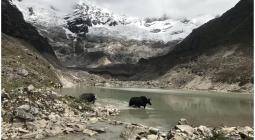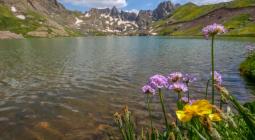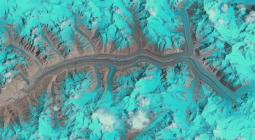Andean alarm: climate crisis increases fears of glacial lake flood in Peru
In 1941, thousands of people died in Huaraz when the natural dam on a lake above the city gave way. Now, melting glaciers are raising the chances of it happening again
Lake Palcacocha is high in the Cordillera Blanca range of the Peruvian Andes, sitting above the city of Huaraz at an altitude of about 4,500 metres. When the lake broke through the extensive moraines, or natural dams, holding it in place on 13 December 1941, it sent nearly 10m cubic metres of water and debris into the narrow valley towards the city, 1,500 metres below.
The result was one of the most devastating glacial lake outburst floods – or “GLOFs” – ever recorded. The force of the water altered the area’s geography for ever, and killed at least 1,800 people, and possibly as many as 5,000.
Like all such lakes, Palcacocha was formed as a glacier receded, the water filling up the hollowed-out land around it. This process – and the floods that can result – is natural but now, scientists say, the climate crisis is increasing the risk it poses.
Peru’s Cordillera Blanca, the eastern backdrop to Huaraz, has the world’s highest concentration of tropical glaciers. While the Himalayas are considered to pose more significant risks of floods, the large population of Huaraz makes the threat to life in this region far greater.
When disaster struck in 1941, Huaraz had a population of 12,000; it is now a thriving city of 120,000 people. “It’s one of the world’s only examples of a major city sitting right beneath a potential risk of a glacial lake flood,” says Neil Glasser, a geography professor at Aberystwyth University. “That makes Huaraz stand out.”
Memories of the 1941 disaster are still passed down through the generations, and those living on the flood path are acutely aware of the risks.
Olga Rosales-Jamanca, 39, lives in the community of Yarush – about six miles east of Huaraz in the valley leading to Palcacocha. Her grandfather told her stories of how he and his wife fled to higher ground during the 1941 flood.
Her father Alejandro, now 69, can also recall its effects. “Before the flood, all of this area was flat with food for animals,” he says. “But after, everything had changed.”
Olga and Alejandro were born in the farmhouse in which they still live, alongside Alejandro’s wife and Olga’s three children, aged one, 15 and 20. She is painfully aware of how devastating a flood could be to her family.
“It would cause a lot of damage to our properties. It would damage all of my efforts here on the farm. It’s a huge risk,” she says, cradling her youngest daughter, Luz.
“I’ve lived here all my life; I feel like this land is my mother,” she says. “My feelings and all my living experience are involved with this land.”
Down the valley, the densely populated district of Nuevo Florida would be the first part of Huaraz to be hit by a flood. Saúl Luciano Lliuya, a 43-year-old farmer and mountain guide, fears what could happen.
Luciano Lliuya has seen the glaciers and landscape shift due to the climate crisis. “The problem is unpredictable, so I don’t know where my family and I would be if it happened,” he says.
“The older guides told me about the mountains and how they are changing. As a farmer and a guide, I have noticed profound changes.”
For the past nine years, Luciano Lliuya has also been embroiled in a landmark legal case, supported by the development organisation Germanwatch, against the German energy company RWE over its alleged role in contributing to the climate crisis, increasing the risk to his home.
The case, which began in 2015, concerns whether RWE should contribute to mitigation measures. It could set a huge precedent for making polluters pay.
German judges visited Huaraz and the lake in May 2022. The next stage is an oral hearing to get expert opinions on flood risks this year.
RWE says the claim has “no legal basis” and “individual emitters are not liable for universally rooted processes”, such as the climate crisis. Whatever the outcome of the case, Luciano Lliuya hopes at least that it will raise awareness of the issue among authorities in Peru and abroad.
GLOFs can happen in two ways. Glacial lakes form behind moraines – natural dams formed by an accumulation of rock and soil left behind by a moving glacier. As glaciers melt, the water level can gradually increase and create greater pressure on the moraines, causing them to give way. Or an avalanche or earthquake could create a shift in the water level and cause it to tip over the moraine, flooding the area below.
A study published last year in Nature Communications suggested GLOFs threaten 15 million people globally. Last October a GLOF killed 92 people in Sikkim, a north-eastern Indian state bordering Nepal, Bhutan and Tibet.
While the exact cause of the 1941 Huaraz GLOF is unclear, scientists’ understanding of the phenomenon has grown in recent decades.
Ryan Wilson, an expert at Huddersfield University who analysed the lakes for the Peruvian government, says: “We now have a combination of satellite-based analysis, which then informs field-based analysis. Once you whittle it down to a collection of ‘interesting’ lakes, you can monitor them continuously using a satellite, which is something we couldn’t do before.”
Scientists warn that the climate crisis is having a serious impact on GLOFs. “If you look at the vast majority of scientific studies, they’re showing an overwhelming thinning of glaciers globally,” Wilson says. “That’s particularly the case in the Andes and Peru.”
Glasser adds: “It’s undeniable: 99% of the world’s glaciers are receding. I think that’s inevitably a consequence of climate change.”
Wilson says people living downstream of such lakes need to be aware of the dangers. “We’ve got a situation where more lakes have expanded and appeared,” he says. “The key thing is education and making people understand.
“These are very high-magnitude floods that can be suddenly triggered. They can travel kilometres within 20 or 30 minutes, and it’s not much time to react.”
While the Peruvian authorities are aware of the risks and have taken steps to mitigate them, local people say more could be done. “A few years ago, the authorities did something to strengthen the lake’s structure, but this year, nothing,” says Rosales-Jamanca.
Inés Yanac, director of the local environmental organisation Wayintsik Perú “our house” in Quechua), says: “People are very worried about the risks of another flood. They are worried about a lack of water if there were a flood and about making the lake much more secure. The water is a vital resource for their animals and crops.”
She adds: “The authorities must solve this problem. There is some alarm system, but it has never been tested.”
Juan Torres Lázaro, of Inaigem, Peru’s glaciology institute, says the system had been tested but had “serious protocol deficiencies”. The regional government was approached for comment but has not replied.
Victor Morales-Moreno, 58, has been monitoring water levels at the lake every two hours for the past nine years. He is critical of how the issue is being managed, saying drainage pipes installed to lower the lake’s level are old and brittle, breaking at the first sign of tension.
Nevertheless, he is more sanguine about the risk. “I’m not worried about another flood because things are under control,” he says.
When an avalanche hit Palcacocha in January, the impact caused a 3-metre-high wave to surge across the lake. Thankfully, it did not cause a GLOF, but Morales-Moreno says all 10 pipes were broken and needed to be replaced. “The pipes are old, and with these high temperatures, they get very dry – they need to be changed.”
Torres Lázaro is now assessing the risk from lakes but it is slow work. Four were completed last year, and another four are scheduled for 2024.
“In 2022, things were calm. But last year and this year, we had two avalanches, which has increased the government’s interest,” he says. “Now, according to the limits, it is considered a risk.”
Cover photo: The Paria and Auqui rivers merge in the Nueva Florida district of Huaraz.






